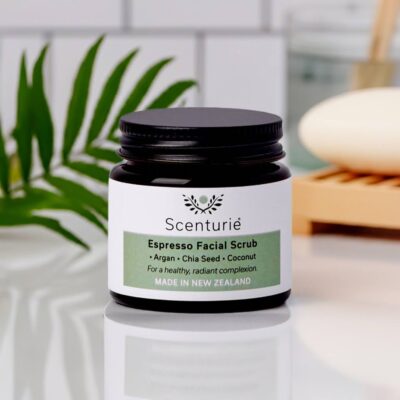Oily Skin in New Zealand: A Guide to Understanding and Managing Excess Oil

Dealing with oily skin can be a frustrating experience, but with the right knowledge and skincare routine, you can achieve a healthy, balanced complexion. Oily skin is characterised by excess sebum (oil) production, which can lead to unwanted shine, enlarged pores, and breakouts.
In New Zealand, with its unique climate and environmental factors, managing oily skin requires a tailored approach. At Scenturie, we understand these challenges and craft natural skincare products designed to harmonise and nurture oily skin. This guide will delve into the causes, characteristics, and effective management strategies for oily skin in Aotearoa.
What Causes Oily Skin?
Several factors contribute to oily skin, often influenced by New Zealand’s specific conditions:
- Genetics: If your parents have oily skin, you’re more likely to inherit this trait. Genetic factors influence sebum production and can make you more prone to oily skin.
- Hormonal Changes: Hormonal fluctuations during puberty, menstruation, pregnancy, and menopause can significantly impact sebum production. These fluctuations can lead to increased oiliness, especially in the T-zone.
- Skincare Products: Using heavy creams or products with comedogenic (pore-clogging) ingredients can exacerbate oiliness. It’s essential to choose lightweight, non-comedogenic products that won’t trap oil and contribute to breakouts.
- Environmental Factors: New Zealand’s environment, with its varying weather patterns, can influence oily skin. Hot, humid weather can stimulate oil glands and increase sebum production. Sun exposure can also dehydrate the skin, leading to a rebound effect where the skin produces even more oil to compensate.
- Lifestyle Habits: Poor diet, stress, smoking, and excessive alcohol consumption can all affect skin health and contribute to oily skin. These factors can disrupt hormonal balance and increase inflammation, leading to excess sebum production.
- Over-Washing: Washing your face too frequently or with harsh cleansers can strip the skin of its natural oils. This can trigger a rebound effect, causing the skin to produce even more oil to compensate for the dryness.
- New Zealand’s Unique Climate: The combination of strong sun, fluctuating temperatures, and sometimes harsh winds can be particularly challenging for oily skin in New Zealand. It’s crucial to protect the skin barrier and choose products that balance oil production without over-drying.
Characteristics of Oily Skin
Recognising the signs of oily skin is the first step towards effective management. Common characteristics include:
- Shine: Skin appears shiny or greasy, especially in the T-zone (forehead, nose, and chin). This is due to overactive sebaceous glands in these areas.
- Enlarged Pores: Pores are visibly enlarged due to excess oil and sebum buildup.
- Breakouts: Oily skin is prone to acne, blackheads, and whiteheads as excess oil can trap dirt and bacteria in the pores.
- Thick Texture: Skin may feel thick or coarse due to the buildup of sebum and dead skin cells.
- Makeup Meltdown: Makeup tends to slide off or break down quickly on oily skin due to the excess oil.
How to Care for Oily Skin in New Zealand
The goal of an oily skincare routine is to balance oil production, prevent clogged pores, and maintain a healthy skin barrier. Here’s a tailored guide for managing oily skin in New Zealand:
- Gentle Cleansing: Cleanse twice daily with a gentle, cream cleanser to remove excess oil and impurities. Look for oil-free and non-comedogenic formulas that won’t strip the skin of its natural oils. Consider cleansers with natural ingredients like harakeke or kawakawa extracts known for their antibacterial and balancing properties.
- Toning: Use an alcohol-free toner with ingredients like aloe vera and neroli flower water to control oil, minimise pores, and soothe the skin. Avoid harsh astringents, as these can irritate the skin and worsen oiliness.
- Water-based Moisturiser: Yes, oily skin needs moisture! Choose a lightweight moisturiser to hydrate without clogging pores. Look for ingredients like hyaluronic acid, which can attract and hold moisture without adding oiliness.
- Exfoliation: Exfoliate 2-3 times a week with a gentle facial scrub. This helps unclog pores, prevent breakouts, and remove dead skin cells. Avoid over-exfoliating, as this can irritate the skin.
- Oil-Control Masks: Use clay face masks or oil-absorbing sheets once or twice a week to absorb excess oil and mattify the skin. Look for masks with ingredients like bentonite clay or charcoal, known for their oil-absorbing properties.
- Sun Protection: Always wear a broad-spectrum, oil-free sunscreen with an SPF of 30 or higher. Sun exposure can dehydrate the skin and worsen oiliness. Choose a lightweight, non-comedogenic formula that won’t clog pores.
- Blotting Papers: Keep blotting papers handy to absorb excess oil throughout the day. These can help mattify the skin without disturbing your makeup.
- Hydrating Serums (Optional): Consider incorporating a lightweight hydrating serum into your routine. Look for serums with hyaluronic acid, which can help balance hydration levels without adding oiliness.
- Lifestyle Changes: Manage stress through exercise, relaxation techniques, and adequate sleep. Eat a balanced diet rich in fruits, vegetables, and whole grains. Avoid smoking and excessive alcohol consumption, as these can dehydrate the skin and worsen oiliness.
- Professional Advice: If you’re struggling to manage your oily skin, consult a dermatologist or a qualified skincare professional. They can help you identify your specific needs and recommend appropriate treatments or products.
- Local Considerations: New Zealand’s climate can be harsh, so it’s important to adapt your skincare routine accordingly. In summer, you may need a lighter moisturiser and more frequent sunscreen application. In winter, you may need a slightly richer moisturiser to combat dryness.
Scenturie’s Approach to Oily Skin
At Scenturie, we are passionate about creating natural skincare products that cater to the unique needs of oily skin. We carefully select plant-based ingredients known for their balancing, harmonising, and nourishing properties. Our formulations are free from harsh chemicals, fragrances, and artificial colours. We believe that nature holds the key to healthy, balanced skin, even for those with oily skin.
Frequently Asked Questions (FAQs)
- Should I moisturise if I have oily skin? Yes, even oily skin needs moisture. Choose a lightweight, oil-free moisturiser to hydrate without clogging pores.
- How often should I wash my face if I have oily skin? Cleansing twice a day, morning and night, is usually sufficient for oily skin. Over-washing can strip the skin of its natural oils and worsen oiliness.
- What are some good ingredients to look for in products for oily skin? Look for ingredients like kanuka oil, aloe vera, charcoal, and bentonite clay. These ingredients can help control oil production, unclog pores, and soothe the skin.
- Is it okay to use makeup if I have oily skin? Yes, but choose non-comedogenic makeup products that won’t clog pores. Mineral makeup is often a good option for oily skin. Always remove makeup thoroughly at the end of the day.
- What’s the best way to manage breakouts on oily skin? Use a gentle cleanser and exfoliate regularly to prevent clogged pores. Incorporate spot treatments with ingredients like tea tree oil or salicylic acid to target breakouts. Avoid picking or squeezing pimples, as this can lead to scarring.
Product Recommendations For Oily Skin
-
Natural Creamy Cleanser
$52.99Select options This product has multiple variants. The options may be chosen on the product pageRated 5.00 out of 5 -
Replenishing Natural Toner
$44.99Select options This product has multiple variants. The options may be chosen on the product pageRated 5.00 out of 5 -
Clay Face Mask Set
$49.99Original price was: $49.99.$44.99Current price is: $44.99.Add to cartRated 5.00 out of 5





